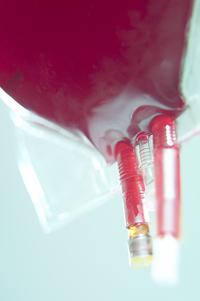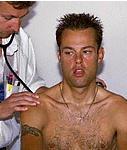News feature, August 25, 2005
Riding under the radar
How to 'prepare' for the big races
Athletes have never been more closely scrutinised and more frequently tested for performance-enhancing drugs, both in and out of competition. Anti-doping authorities regularly make confident statements about the efficacy of the regime. But can athletes still beat the system? Jeff Jones reports.
Testers vs users: the arms race in sportDetecting drug use and evading detection has become a contest in and of itself. On one side, there are athletes who will cheat to gain an advantage over their rivals through means of illegal performance enhancing drugs and methods; and on the other there are the drug testers, scientists, and governing bodies who try to prevent this from happening. Although the latter have been catching up in recent years, it's still possible for anathlete to avoid testing positive for banned drugs, even those that can be tested for. The drugsFor the past 15 years, artificially injected erythropoetin (EPO), the wonder drug that was developed for treating severe cases of anemia, has been used by endurance athletes to improve their performances illegally. EPO is produced naturally by the body, and it stimulates red blood cell production. Inject it, and you get more red blood cells, which provide your muscles with more oxygen to perform their work. In any endurance sport, oxygen delivery to the muscles is usually the main limiting factor to performance. In a similar vein is autologous blood doping, which involves removing blood a few weeks prior to competition then replacing the red cells just before the event. The body has regenerated the blood in that time, so the additional red cells provide extra haemoglobin and therefore a greater oxygen capacity. A more risky procedure is homologous blood doping, which involves injecting a different person's (with compatible blood) red blood cells, giving the same boost. Although it eliminates the inconvenience of an athlete to withdraw/regenerate their own blood in the first place, it carries with it a greater risk of contracting blood borne diseases such as HIV/AIDS, as well as becoming sensitised to minor blood group proteins, so that transfused blood may be rejected further down the line. Two other illegal compounds, commonly associated with performance enhancement, are growth hormone and testosterone. These are anabolic agents, which stimulate the body to grow and regenerate. Since a competing endurance athlete is often in a catabolic state, these substances can be used to recover after a hard race and prevent muscle loss. Or for a sprinter-type, they can be used to increase the size and strength of their muscles, and therefore greater performance. The testsCurrently, there is a test for EPO, one for homologous (not autologous) blood transfusions, and a "limit" for testosterone. A test for growth hormone is on its way, but up until now it has been a mirage. The urine test for EPO is currently undergoing improvements, but it has been used in sport since the 2000 Olympics and was introduced in cycling in 2001. It uses electrophoresis to detect a standard injection of EPO for up to three days (72 hours), by means of comparing the quantities of "basic isoforms" of certain proteins in a urine sample. The more basic isoforms present, the greater the likelihood that the person had injuected EPO within the last few days. A normal person would have less than 40 percent basic isoforms, while someone who had taken EPO could have between 80 and 100 percent, allowing for a very wide margin of error. Given the effectiveness of EPO is up to several weeks, a three day detection window has always been considered inadequate. A blood profiling test was introduced in July 2004, which could not only determine whether EPO had been injected within the last five days, it could tell - using a slightly more indirect approach - whether blood had been boosted in any way for up to four weeks. This represented a big step in drug testing, because it did not focus on any particular substance, but the physiological changes that it made. The test for homologous blood transfusion was introduced in 2004 as well, and is based on flow cytometry and determining whether there are any differences in minor blood antigens in an athlete's blood. Claiming a detection time of up to 120 days, the test has so far picked up Phonak teammates Tyler Hamilton and Santiago Perez as positives, but there are still some doubts over its validity. There is no cast-iron test to detect use of testosterone. Rather, a limit is applied to the ratio of testosterone to epitestosterone in a person's urine. Most people have a ratio of between 1.5-2:1, but the limit - like the blood hematocrit limit of 50 percent - is 4:1 (for men) to allow for those with naturally high testosterone levels. If it's greater than this level, then it's considered a positive unless an athlete can prove that he is always this high. |
 |
When athletes test positive for performance-enhancing substances, they often point to a long history of negative tests as evidence of their innocence. In cycling, riders such as David Millar have subsequently confessed to using banned, detectable substances at times when they must surely have been under scrutiny.
The question that must be asked, in the light of such incidents and l'Equipe's accusations against Lance Armstrong, is: is it still possible to take illegal performance enhancing substances but remain clean in the eyes of the drug testers? A confidential medical source told Cyclingnews that they believed it was quite possible, and outlined a simple but plausible method to do it.
1) EPO can be taken in smaller doses but on a regular basis, which has several advantages over taking one big hit every now and again. Firstly, it reduces the possibility of detection by the urine test by lowering the percent of basic isoforms (see sidebar) in the urine.
A smaller dose means a drug tester might only have 12 hours to detect the last injection, and given the fact that drug tests aren't usually carried out in the middle of the night, this leaves only a very small window open.
Taking small, regular doses also simulates the body's natural physiology more closely than a super-sized dose, which means that it could even get under the radar for the longer term blood testing.
 |
Presumably that would require a more care to be taken over the course of a season, but with a knowledgeable doctor's supervision, that is entirely possible.
2) Autologous blood doping is still undetectable, and not particularly complicated. In this technique, the athlete extracts and stores some of their own blood, and reinfuses it when the body has recovered its normal red blood cell level. The effect is an immediate boost in red cells and oxygen carrying capacity.
All that's required is a set of bags and tubing, the proper substance to preserve the blood overnight, and a fridge. The blood - which can also be boosted with EPO - can be withdrawn in the weeks leading up to a big event, when an rider is not in competition.
Then it can be reinfused on the morning of an important stage, even as late as 9:00am, which is after any possible UCI medical inspector visits, but before the stage starts.
The red cell boost could enable a rider to do the stage with an elevated hemoglobin/hematocrit, and oxygen carrying capacity to burn. But they should have enough time to rehydrate and get back to normal before a possible blood test the next morning.
A urine test on the day should present no problems, as there will be no traces of artificial EPO left. To coin a phrase, it's like "racing high, sleeping low."
This method might only be used a few times during the course of a three week stage race, but it's considered to be even more effective than merely taking EPO.
 |
Autologous blood doping requires careful scheduling of the athlete's racing program. Red cells can be stored for up to 42 days if properly refrigerated, but the body needs time to replace the red cells that have been removed.
Usually, red cells survive for 120 days and the body produces them at a replacement rate, but if blood has been lost the body can increase its rate of production as much as seven-fold.
It's therefore possible that the red cell level would be back to normal after about three weeks, giving a three-week 'window of opportunity' to use the stored cells.
Athletes might therefore stop racing for a period some weeks before a major event and closet themselves away for a 'training camp' somewhere remote and secluded.
In a situation where it's hard to be subjected to an out-of-competition test, they can store red cells and spend time recovering from their extraction without the resulting sudden and suspicious drop in racing performance.
3) Recovery products such as growth hormone and testosterone can be used with little risk of detection, at least with the current methods. Growth hormone is undetectable at the moment anyway, while testosterone can be injected as long as the athlete stays below the 4:1 testosterone:epitestosterone ratio. If his normal ratio is 2:1, that gives him a wide range to work within.
This situation is similar to that of blood before the EPO test was introduced, when the 50 percent hematocrit rule was the only limit preventing riders from injecting unhealthy amounts of EPO. A rider could start at 41 percent and go all the way up to 49.9 percent without being declared "unfit to start". Even that only warrants a 2 week suspension, as it's not a positive test.
There is no doubt that the current tests are still catching riders, as it's not always possible to be this careful. And certainly, the introduction of a powerful blood test has made it easier to pick up changes in a rider's profile over the course of a season, and determine whether to target test them.
Add in a harsher penalty for missing an out of competition test, and the net becomes tighter. But as the above shows, there is clearly a lot more work to be done if doping is to be eliminated from cycling.
Cyclingnews coverage of the L'Equipe allegations
June 27, 2006 - Carmichael
defends Armstrong, Armstrong answers L'Equipe & LeMond
June 26, 2006 - LeMond:
"Armstrong threatened my life"
June 19, 2006 - Armstrong calls for Pound's exit
June 18, 2006
- Lance Armstrong's open letter against Dick Pound
June 4, 2006 - UCI hits back at WADA
June 3, 2006 - WADA slams the Vrijman report
June
2, 2006 - L'Equipe stands by its story, UCI supports Vrijman's findings
June
1, 2006 - UCI, WADA and Armstrong react to Vrijman's report
May 31, 2006 - UCI lawyer
asks for Armstrong's name to be cleared
May
14, 2006 - Two more weeks for Armstrong investigation
Click here for full coverage of the L'Equipe allegations.

